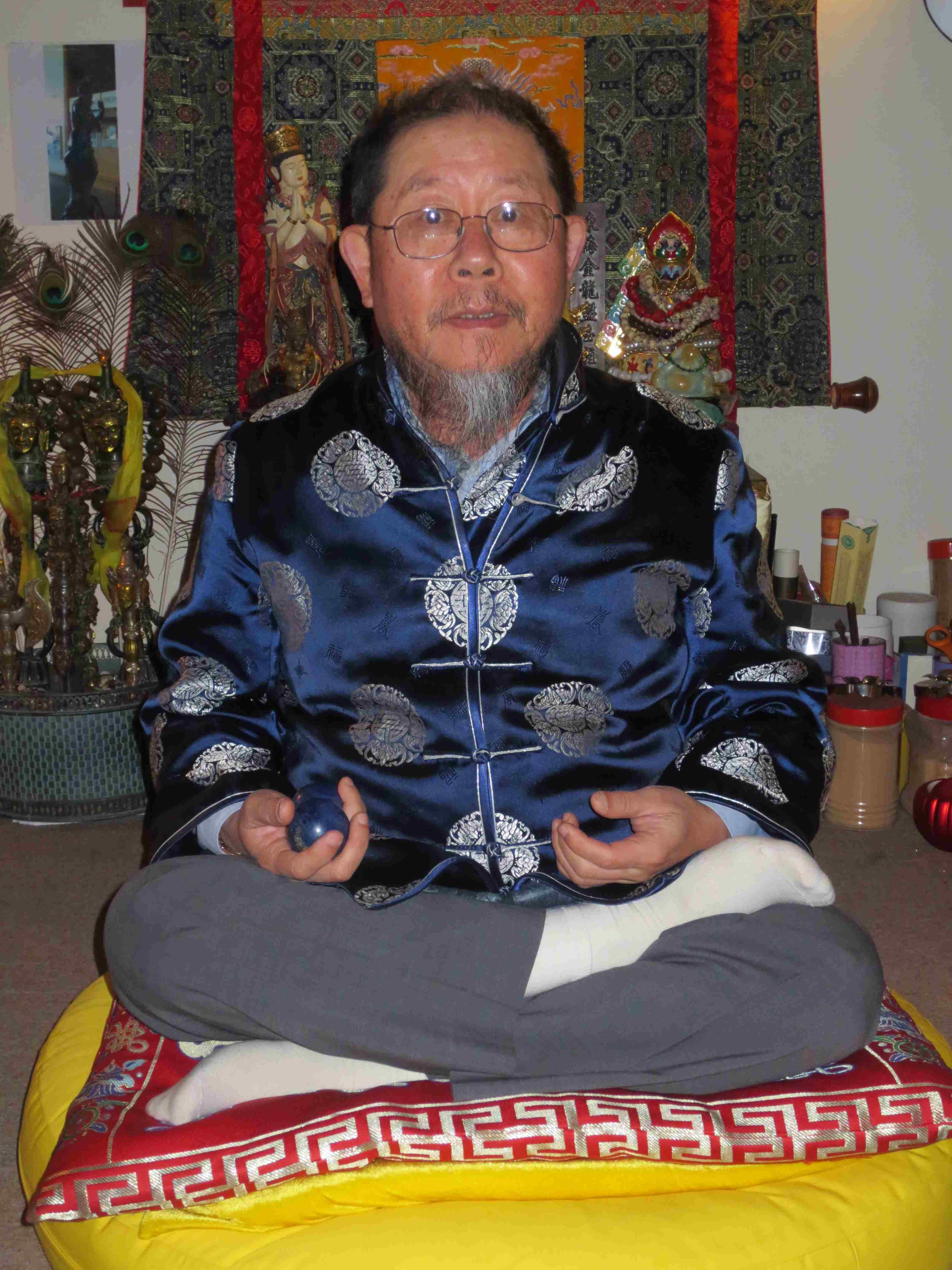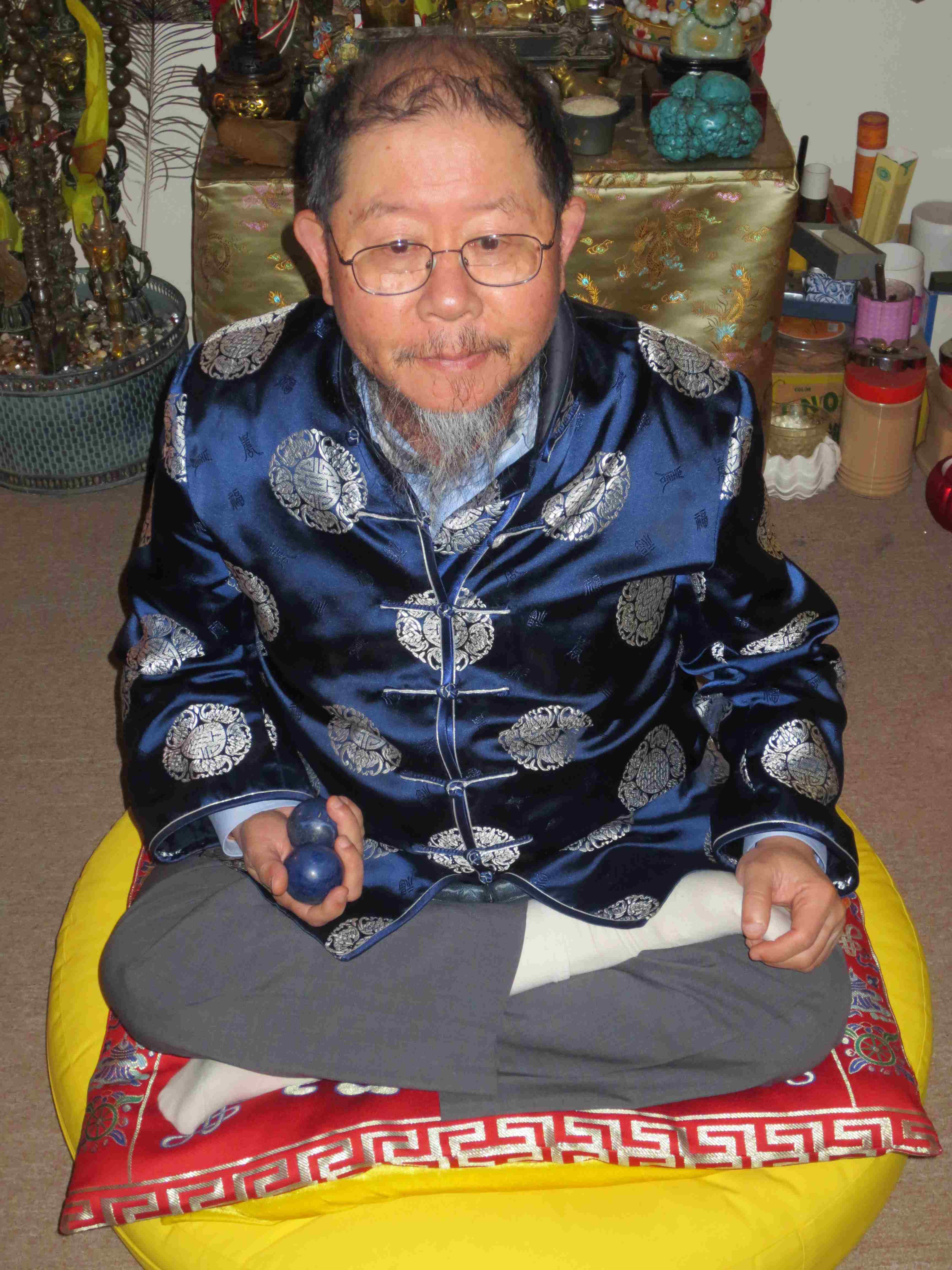健身球之道
簡繁轉換 - 繁體
林鈺堂
當我接送小兒安昌去哈定小學時,一邊走路,我兩手同時各玩一對健身球。許多過往的行人以及哈定小學的老師、家長及小朋友們都為之側目。許多人問我這是幹什麼的,或者要我教他們如何玩法。第十一教室及第十三教室的兩位老師還特地安排了一場聚會,讓我在二十分鐘內為小朋友們講解及示範。這兩班的小朋友是從幼稚園到二年級的。七年前我曾作〈健身球念佛〉一文,以提倡此種運動,並將之譯成英文,贈閱大眾。經過十餘年的修習,我對此道已有更多的體驗及心得可以提供大家參考,因此將舊作加以增益,而成此篇。
手、腳及耳朵這三個部位都與全身其他各部有反射作用的關連,因此有以按摩或針灸這些部位來治病或保健的。我並不通達這些學問,只想利用這方面的基本常識來保健。一般人大約也和我一樣,雖無能深入了解,卻希望能得些實用的好處,因此我把自己摸索所得公開,獻給非專家的大眾。
在拙作「一曲十彈」書中,有一篇「石頭路上好經行」。這篇文章並不涉及專門而複雜的腳底按摩法,只介紹藉步行石路而自然得按摩效果,還建議邊走邊念佛,使調身與修心合一,效果更佳。本文也是不提手部按摩,只推薦健身球運動,以期大家「不知亦能行」,自然得按摩之效果。當然,健身球與念佛同時進行,也易達到身心專一的境地。
健身球的操練原先是由明朝的一位功夫師傅所傳授的。至今依然是知名的保健運動,並且已經流傳到了西洋。在中國有些地區這可是盛行的玩藝兒。特別是在河北的保定,走在街上,到處可見手中玩球的人們。這也難怪,因為此地便是健身球的發源地。
健身球運動是將兩個等大、等重的圓球放在一手中,然後以五指將兩球旋轉,不停地移動位置。有的人會覺得順時鐘方向轉球是自然的,有的人則覺得逆時鐘方向才順手。就這一點而言,人的手似乎可以區分為兩類。這種天生的分別是因人而異的;每個人要自己試試纔知道。最好先練習順手方向的轉球,等到有些熟練了,才再加練逆向的轉球。初學者最好只練單手玩球,而交替練習使用左、右手。等到兩種轉向都熟練了,就要將球順、逆時鐘方向交替旋轉。如此互補運用可以充分發展手掌的潛在功能。經由這樣柔和的運動,十指漸漸練得十分靈巧,而全身鬆馳有若感受一波波的輕撫。
在舊金山的中國城可以找到健身球,依質地分為金屬、景泰藍及玉石三種。球的大小有四、五種。金屬及景泰藍球都是中空而含藏音板,並且一對球分藏兩種音板,互相調和。據說練球聽音可以調心。《楞嚴經》裡提倡的「觀音圓通」法門,也可以用上。
開始練習時我用小號的金屬球,因為不靈活的手指玩不來大球;又因為時而掉球,用金屬的比較不會摔壞。我是兩手各玩一對球,同時練。雙手自然地都是將球由姆指經中間三指,向小指方向轉動,也就是說,右手逆時鐘,左手順時鐘。反其道而行,則十分笨拙,原來雙手從未如此使用過。我發現玩健身球令我在雙手的使用上,開擴了一個新的領域。
在飛機上或其他公共場所玩健身球,恐怕聲音吵到鄰座的人,我便買了一對實心的玉石球。到底還是天然的質地好些,玉石球在手中更覺舒服。有時玩金屬球會有靜電的感覺。景泰藍球摸起來並不舒服,所以我沒試用。
練了一些時日後,就覺得小球渾如無物,得改用較重的大號球才舒適。運球時,除了手部可以覺受有那些地方不順暢,玩久了,有時身體其他部位也同時感覺其影響。每當讀書、寫作累了,我就起來走走,手中玩著球,很快就使身體恢復了鬆軟的狀況。有時我還一邊手中玩球,一邊赤足走在石頭路上。(被太陽曬暖的石路,赤足走起來真舒服。)
在浸淫此道十餘年間,我逐漸察覺:玩健身球時,下臂、上臂,甚至連同後背與前胸也都微妙地配合著在動。起初是在練習了好幾個月之後,才感覺到下臂也在運動,因為那時下臂已經不如以往的僵硬了。久久之後,才漸漸感覺上臂也在運動。長年的練習之後,才感覺到背部也在運動。現在則是能感覺連胸部也有微動。當然,最顯著的感覺是兩手皆整體在動著。正在轉球時,我覺得石球是柔軟的,而十指靈巧,運轉不息,猶如自動。
健身球是很好的運動,動作柔和,久玩不累,使人靈活,促進全身血氣順暢。又不需要昂貴或佔地方的裝備,隨時隨地可以操練,男女老少都可把玩。對於老人及有些局部殘障的人更是適宜。各種行業的人因為長期使用一種姿勢與某些部位,而易形成職業病,如果利用健身球不時調節,應該是經濟而又實惠的抒困之道。常玩健身球,保持血氣的順暢運行,應可預防關節炎,又使手腦皆較靈敏,應可防止老年之癡呆。也有好動的小孩在練習健身球後轉為沉靜。好處說不完,大家最好試試。
現在我雙手同時各玩一對球,可以隨意改變方向,使兩對球同方向或逆方向旋轉。據說練習久了,還可以加到一手三、四球。玩熟了,還可以配合其他運動,例如韻律體操或者踏著太極拳的步法。我還將之與背向行走配合。背向而行使我運用到一些平生罕用的肌肉。並且,由於需要轉頭向背後看路,便可順帶輪流向左後及右後轉頭而運動脖子。這樣看路,變成向所有方向都看,頗有開展視野之效。遇到長途坐車或飛行,我都帶著健身球,隨時用來運動調節。家人親友,不分老幼,我都告訴他們練健身球的好處,還為家人買了球。
任何運動都忌心中雜亂。心中純一,萬事好辦。練健身球時,心中不斷念佛,則易達到身心的純一、和諧及靈活。已經念佛多年,有志常念直到往生淨土的佛友,也許可以不用念珠計數,而改用更圓滿、靈活的健身球運動,來促成身心的一致。至於基督教徒,則可以配合持念耶穌的禱文:「主耶穌,神之子,恩光降臨帶罪的我」。
當健身球正在旋轉時,旋轉不停是「常」,移動不住是「無常」,正好可以用來說明佛法所謂「不落兩邊」的意思。事物本身並非一偏之見所能局限;我們不要被自己的成見所縛,而遠離了真實。
願有緣見聞此篇者都感興趣而練習之。我深覺此法裨益身心,願修習者同享此種覺受,而有過之。如果在坊間一時找不到健身球,可以用任何兩個等大、等重的圓球,或者兩個胡桃來代替,而開始練習。
一九九九年六月七日 養和齋 於加州
相關文章:黑檀球
照片:(2014-05-21補入)


Playing with Health Balls
Yutang Lin
As I walk my son Andrew to and from Harding Elementary School on weekdays, I play in both hands a pair of health balls. This has attracted much attention from many passers-by along the way and parents, teachers and students at Harding. Many have asked me to explain about this exercise or show them how to do it. I was even invited by teachers in room 11 and room 13 to give their students (from kindergartners to second graders) a short talk and demonstration on this exercise. Previously, I wrote an article in Chinese and English on this practice; it was entitled "Chanting with Health Balls." Now that I have had more experiences with this exercise and more related ideas to offer, I am writing this new article based on the old one.
Human hands are sensitively connected to the rest of the whole body. Hence, by massaging different parts of the hands, various parts of the body can be stimulated. Feet and ears are similarly related to the whole body. Chinese medicine teaches healing techniques that involve massage or acupuncture applied to these sensitive parts. However, to promote one's general well-being no professional knowledge is needed; all one needs is to adopt some simple exercises on a daily basis. For example, one may adopt the habit of massaging ears whenever one is waiting for a green traffic signal, or one may walk barefoot on pebble paths for fifteen to thirty minutes daily. This article talks about a traditional Chinese hand exercise called health balls.
This exercise originally was taught by a martial art master in the Ming dynasty of China. To this day it has remained a well-know exercise for the promotion of good health. It is a popular exercise in some parts of China, especially in Bao Ding of He Bei province, the place where it originated.
To play with health balls, one holds two balls of equal size and weight in one hand and, using the fingers, rotates them constantly. Depending on the individual, some would find the clockwise rotation natural, while others would find the counterclockwise rotation natural. It seems that there are two types of hands as far as this rotating movement is concerned. First practice rotating in the direction that is natural to you, and later practice rotating in the opposite direction only after you have already become familiar with the natural rotation of balls. A beginner should practice with only one hand at a time, and alternately practice with either hands. Eventually, it is better to practice rotating the balls both clockwise and counterclockwise alternately because they are complementary exercises, and in this way the full potential of the usage of hands will be realized. Through this gentle exercise the fingers become dexterous and the whole body experiences constant waves of soothing massages.
The health balls found in the stores in San Francisco's Chinatown are made of metal, cloisonn?or stone. There are four or five sizes. One needs to choose the size that suits ones hands by trying them out. It is advisable for beginners to start with metal balls because at the beginning it is inevitable that the balls would slip and fall frequently. The metal and cloisonn?balls are hollow with sounding boards inside. Each pair of balls contains sounding boards of different pitches so that the chorus is harmonious. It is said that listening to this sound while rotating the health balls may pacify the mind. For Buddhist practitioners who are interested in practicing the meditation on listening as taught by the great Bodhisattva Avalokitesvara in the Surangama Sutra, this would be a good source of sound to listen to. The stone balls do not come with the sound effects, but it is a blessing when you want to practice in public without disturbing others nearby. Besides, it feels much more comfortable than the metal balls which sometimes would produce static. Cloisonn?balls do not feel comfortable; therefore, I have never practiced with them.
I began my practice with small metal balls because my fingers could not rotate the bigger ones with ease and even then, the small balls would fall through my fingers. After becoming accustomed to rotating one pair of balls at a time, I practiced rotating one pair of balls in each hand simultaneously. It soon became apparent that rotating the balls counterclockwise in the right hand and clockwise in the left hand are easier to do, because in that way, the thumb pushes the balls toward the pinkie. When I tried to rotate the balls in the reverse direction it became very awkward. In fact, I had never used my fingers in that way. Practicing health balls opened up a new horizon for my dexterity.
After using the small health balls for a few days, I could hardly feel their presence in my hands. I then switched to the larger balls and felt comfortable with them. While practicing the health balls, I become more aware of the areas on my hands that are tense or sore and, gradually, also other parts of my body that are not at ease. Doing this exercise does help release tension. Whenever I become tired of reading or writing, I walk around and play the health balls. In this way, my body soon returns to a relaxed and supple condition. Sometimes I walk barefoot on pebbles in my yard while simultaneously playing the health balls. (It is so comfortable to walk barefoot on pebbles warmed by the sun.)
Now I have practiced health balls for more than a decade. During this time I gradually became aware that, while rotating the balls in my hands, my lower arms, my upper arms, and then even the back and front of my torso are also involved in very subtle ways. After months of practice, I first became aware of the involvement of my lower arms because they were no longer as stiff as before. Then, gradually I sensed the upper arms are also moving, and much later even the back of my body. Now I sense all the above mentioned parts are involved in the exercise, especially the whole arms. When I play the health balls I feel the balls are soft and the fingers move so smoothly that it would seem automatic.
Playing health balls would be an ideal exercise for people of all ages because it is gentle, and helps improve one's dexterity and circulation of blood and inner air (Qi). It is an exercise that one can do almost anywhere, without clumsy and expensive equipment. Health balls are suitable especially for the old or disabled. This exercise can promote the circulation of blood and inner air; consequently, it could prevent arthritis. It keeps one alert, and hence is a good preventive measure for Alzheimer. It is known to have helped calm down children with hyperactivity. It is well known that occupational stress and the lack of ergonomic awareness have caused many serious health problems. The practice of health balls may turn out to be an effective and economic solution to such occupational problems.
After months of practice I can rotate simultaneously one pair of health balls in each hand in any direction I want; both clockwise, both counterclockwise, or one clockwise and the other counterclockwise. Experienced practitioners can even play with three or four balls in each hand simultaneously. In fact, one can even combine this exercise with activities such as Tai Ji Quan (Tai Chi) or dances, etc. I have also combined this exercise with walking backwards. Walking backwards helps me to develop some muscles that I have seldom used, and the need to look backwards provides an opportunity to turn my neck to the right rear and left rear alternately as an exercise. I carry a pair of health balls with me on long trips to help adjust my physical condition. To all kinds of people I spread the message of the benefits of this exercise, and I bought health balls for members of my family.
Any physical exercise should be free from mental distractions to be beneficial. With concentration all activities are neatly accomplished. While practicing the health balls it would help induce harmony of body and mind by chanting the name of a Buddha or a mantra. Christians may chant a short prayer such as the prayer of Jesus: Lord, Jesus, son of God, have mercy on me, a sinner. Buddhist practitioners, who are well versed in the chanting practice and are determined to continue their chanting practice until their rebirth in Buddha's Pureland, may use health balls instead of prayer beads and do without the counting of numbers of repetitions. As physical exercise the rotation of health balls is more beneficial than the monotonous movement of prayer beads by the thumb.
While the health balls are rotating, the rotation is constant and yet the positions are impermanent. This observation serves well to illustrate the significance of a fundamental Buddhist teaching that one should not be confined by either side of the dualistic views. The reality as such cannot be encompassed by one-sided views; we had better not be limited by our own prejudices and lose touch of reality.
May all who come across this article become interested in this practice and benefit from adopting this practice. If health balls are not readily available in your surroundings, you can still begin the practice with any round object such as two large marbles or walnuts.
March 31, 1999
El Cerrito, California
[Home][Back to list][Playing with Health Balls][Related works:Black Sandalwood Balls]